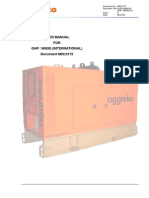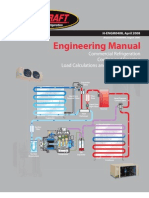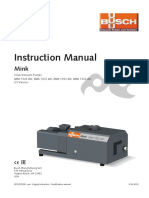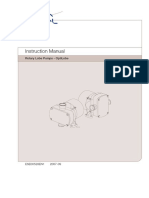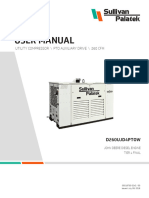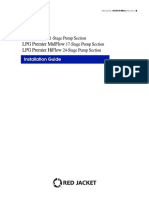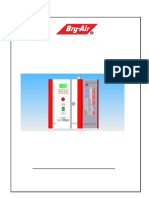HPP20 4
HPP20 4
Uploaded by
Arief supriyatnoCopyright:
Available Formats
HPP20 4
HPP20 4
Uploaded by
Arief supriyatnoOriginal Title
Copyright
Available Formats
Share this document
Did you find this document useful?
Is this content inappropriate?
Copyright:
Available Formats
HPP20 4
HPP20 4
Uploaded by
Arief supriyatnoCopyright:
Available Formats
HPP20-4 INSTRUCTION MANUAL Page 1
INSTRUCTION MANUAL
HPP20-4
HYDRAULIC PRESSURE PUMP
This manual was prepared to present the correct methods and procedures of operating and
maintaining your ALMEX Hydraulic Pressure Pump.
At the time of writing this manual, the instructions were up to date. However, some of the
information or appearance of the component parts may vary slightly from the product
delivered to you.
Read this manual carefully before operating your vulcanizer.
SHAW-ALMEX INDUSTRIES LIMITED
P.O. Box 430
Parry Sound, Ontario, Canada P2A 2X4
Phone: 705-746-5884 or 1-800-461-4351
Fax: 705-746-9484
E-Mail: sail@almex.com
Web Site: www.almex.com
SHAW-ALMEX INDUSTRIES LIMITED 49904-002 December 97
Rev. Feb 1999, Jun 2001
HPP20-4 INSTRUCTION MANUAL Page 2
Table of Contents
1. RECORD OF PURCHASE ...............................................................................................................3
2. SAFETY .............................................................................................................................................4
2.1. Definition of Pictograms .................................................................................................4
2.1.1. Safety Alert .................................................................................................................4
2.1.2. Electrical Hazard.........................................................................................................4
2.1.3. Crushing Hazard.........................................................................................................4
2.2. Limitation of use .............................................................................................................4
2.3. Hazardous Materials and Products ................................................................................5
2.4. Safe Handling .................................................................................................................5
3. ASSEMBLY .......................................................................................................................................6
3.1. Functional Diagram ........................................................................................................6
3.2. Assembly ........................................................................................................................6
4. OPERATION......................................................................................................................................7
4.1. Pressurizing the Vulcanizer............................................................................................7
4.2. De-Pressurizing the Vulcanizer ......................................................................................7
5. MAINTENANCE ................................................................................................................................7
5.1. Routine Maintenance .....................................................................................................7
6. TROUBLESHOOTING......................................................................................................................8
6.1. Pump will not Start..........................................................................................................8
6.2. Vulcanizer will not Pressurize or Loses Pressure ..........................................................8
7. Service ...............................................................................................................................................8
7.1. Emergency Service ........................................................................................................8
7.2. Return of Goods Authorization .......................................................................................8
7.3. Guarantee.......................................................................................................................8
SHAW-ALMEX INDUSTRIES LIMITED 49904-002 December 97
Rev. Feb 1999, Jun 2001
HPP20-4 INSTRUCTION MANUAL Page 3
1. RECORD OF PURCHASE
Job Number
Date of Purchase
Model Number HPP20-4
Serial Number
Weight Dry 100 lb. [45 kg]
Full 300 lb [135 kg]
Operating Pressure 200 psi [1380 kPa]
Voltage
Phase
Cycle/Hertz
Amperage
Calibration Pressure
Spare Parts
Operating Instructions 49904-002
Supplements
Service Bulletins
Warranty Card
Drawings MWD573
Parts Diagrams D7
SHAW-ALMEX INDUSTRIES LIMITED 49904-002 December 97
Rev. Feb 1999, Jun 2001
HPP20-4 INSTRUCTION MANUAL Page 4
2. SAFETY
The following safety precautions should be read carefully and understood thoroughly before you set-up or
operate your vulcanizer. Failure to follow these precautions may result in personal injury and/or equipment
damage. All operating personnel should be trained in the proper method of handling and operating the
vulcanizer.
The risks associated with operating the vulcanizer with the Hydraulic Pressure Pump Control are identified
throughout this manual with pictograms.
2.1. Definition of Pictograms
Safety Alert Electrical Hazard Crushing Hazard
2.1.1. Safety Alert
1. The operating pressure of the Hydraulic Pressure Pump Control must match the operating pressure
indicated on the vulcanizer serial plate.
2. Never operate the press while unattended.
3. The upper frame must be securely assembled to the lower frame before pressurizing vulcanizer. Do not
lean against or over top of the vulcanizer during operation. Since high stress levels are resident in the frame
and assembly members during operation, component failure can result in parts being projected upward or
outward.
4. Do not connect the vulcanizer to a continuous pressure supply. In the event of component failure, it is
important for the pressure to drop to a safe level.
5. Do not tamper with the Pop Safety valve. It is factory preset to prevent the vulcanizer from operating at
unsafe pressures.
2.1.2. Electrical Hazard
1. A qualified electrician should perform all maintenance of the electrical components of the Hydraulic
Pressure Pump.
2. All of the electrical components contain live circuits. Do not service any of the electrical equipment
without disconnecting the main power supply.
3. Incorrect voltage and phase may result in component damage and create a fire hazard.
4. Equipment power supplies must be properly grounded or a severe shocking hazard may result.
5. Avoid using equipment in wet surroundings or a severe shocking hazard may result.
6. If any cable or connectors are damaged, they must be replaced or a fire and shock hazard may result.
2.1.3. Crushing Hazard
1. Fingers must not be placed between platen surfaces when the vulcanizer is pressurized or injury will result.
2.2. Limitation of use
The HPP20-4 has been designed to indicate and regulate the liquid pressure of ALMEX conveyor belt
vulcanizing presses. The process of vulcanizing is done by applying a combination of heat and pressure on the
product for a certain period of time. The HPP20-4 generally operates at various pressures within a range of 0-
200 psi (1380 kPa). There is a pop safety valve that must be used. A continuous pressure supply must not be
SHAW-ALMEX INDUSTRIES LIMITED 49904-002 December 97
Rev. Feb 1999, Jun 2001
HPP20-4 INSTRUCTION MANUAL Page 5
connected to the pump or the vulcanizer. The press must never be allowed to operate while unattended. A hose
is attached to the pressure pump for connecting to the vulcanizer. Other use is not allowed without the written
permission of Shaw-Almex.
2.3. Hazardous Materials and Products
It is recommended that the hydraulic pressure pump reservoir be filled with water and glycol. Refer to the
safety precautions for the glycol.
The pump will supply liquid at pressures up to 200 psi (14 kg/cm2). If a leak should develop, the liquid may
spray workers in the surrounding area.
2.4. Safe Handling
Handling the pump does present some residual hazard. Weight is listed in the record of purchase. The pump is
mounted on wheels for moving and care must be taken so the pump does not upset and fall on the operator.
Hoisting provision is provided on the top of the pump reservoir and hoisting equipment can be used to move
the pump into position.
Wear protective footwear when handling the pump.
Connection of cables and hoses must be made in such a way that no tripping hazard is created.
SHAW-ALMEX INDUSTRIES LIMITED 49904-002 December 97
Rev. Feb 1999, Jun 2001
HPP20-4 INSTRUCTION MANUAL Page 6
3. ASSEMBLY
3.1. Functional Diagram
8
9 1. Drain Cock
10 2. Strainer
3. Motor
4. Pump
5. 2-way Pressure Release Valve
5
6. Safety Relief Valve
7
11 (hidden) 7. Check Valve
6 8. Pressure Relief Valve
3 9. Pressure Gauge
10. Start/Stop Switch
11. Sight Gauge
1, 2
3.2. Assembly
Safety: The operating pressure of the Hydraulic Pressure Pump must match the operating pressure
indicated on the vulcanizer serial plate.
Safety: The pump should be operated on a flat, level and stable surface so there is no danger of falling.
Safety: Ensure the voltage phase and cycle on the hydraulic pressure pump serial plate is the same as the
power supply.
1. Fill the pump reservoir with a 50-50 mix of water and ethylene glycol (anti-freeze). The fill level is visible
through the sight gauge.
Note: If there is no danger of freezing and commercial pump lubricants are not available, a mixture of water
and 10% glycerin should be used to provide lubrication for the pump.
2. Locate the pump near the vulcanizer. Avoid placing the pump higher than the vulcanizer or the pressure
bag may not drain properly.
3. Connect the pump pressure hose to the pressure bag fitting or the bag hose manifold on the vulcanizer.
4. If your pump has been supplied with an additional reservoir, there will be a quick connect fitting at the
drain cock. Connect the Reservoir hose to this fitting.
5. Connect the pump power supply cord. There may be a connector on the temperature control panel for the
pump. Check the serial plate for the correct voltage and phase.
Important: Before disconnecting the pump hose from the vulcanizer, ensure the pressure has been released.
Failure to do this will result in a sudden uncoupling of the hose from the vulcanizer and pressure will be
trapped in the bag. It is very difficult to reconnect the fittings while under pressure, and it will be very
difficult to release the pressure from the bag without the fittings connected.
SHAW-ALMEX INDUSTRIES LIMITED 49904-002 December 97
Rev. Feb 1999, Jun 2001
HPP20-4 INSTRUCTION MANUAL Page 7
4. OPERATION
4.1. Pressurizing the Vulcanizer
Safety: Do not lean against the vulcanizer when pressurizing. Component failure can result in
components being projected upward or outward. People must stay clear of the area when press is in operation.
Safety: The safety relief valve is preset to blow off at a pressure slightly higher than the operating
pressure shown on the serial plate. Do not override this safety device or injury could result.
Safety: Fingers must not be placed between platen surfaces when the vulcanizer is pressurized or injury
will result.
Important: Make sure fluid is entering the pressure bag and the pressure is rising before beginning to heat the
vulcanizer.
1. Close the pressure release valve by turning the handle to the horizontal position.
2. Press the starter switch and pressurize to desired pressure. The pressure gauge may not read an accurate
pressure while the pump is running so it is recommended that the pump be switched off occasionally to
read an accurate pressure. Do not exceed the operating pressure indicated on the vulcanizer serial plate.
3. The pressure relief valve can be adjusted to the required operating pressure. When the pump reaches this
pressure, the fluid will bypass the pressure bag hose and return to the tank. This helps to prevent over
pressurization and is very useful when operating the pump at pressures less than 200 psi. (1380 kPa).
4. When the pump reaches operating pressure, press the stop switch.
4.2. De-Pressurizing the Vulcanizer
1. To de-pressurize the vulcanizer, slowly open the pressure release valve by turning the handle to the
vertical position. Opening this valve fast will cause undue pressure in the reservoir.
2. When the pressure has dropped to zero and the fluid has stopped flowing, the pump can be disconnected.
5. MAINTENANCE
There are no special tools required to maintain this equipment.
5.1. Routine Maintenance
The following items should be checked after every thirty cures.
1. Check the fluid level in the reservoir.
2. Without connecting the Hydraulic Pressure Pump to the vulcanizer, switch the pump on and ensure that the
Pop Safety valve operates approximately 10% above the pressure indicated on the serial plate.
3. Remove and clean the strainer.
4. Tighten any loose fittings.
5. Check hoses and pressure bag for signs of wear that might cause a leak. Repair or replace any worn parts.
SHAW-ALMEX INDUSTRIES LIMITED 49904-002 December 97
Rev. Feb 1999, Jun 2001
HPP20-4 INSTRUCTION MANUAL Page 8
6. TROUBLESHOOTING
6.1. Pump will not Start
FAULT CORRECTION
1. Power supply not correct. 1. Check power supply.
2. If connecting pump power 2. Check and replace fuses in the temperature controller.
supply to temperature Refer to temperature controller manual.
controller, fuses in the
controller may be open.
6.2. Vulcanizer will not Pressurize or Loses Pressure
FAULT CORRECTION
1. No fluid in the reservoir. 1. Fill reservoir with correct mixture of water and antifreeze.
2. Pressure release valve in the 2. Turn the pressure release valve to the pressure position.
wrong position.
3. Pressure relief regulating valve 3. Raise the pressure setting on the pressure relief valve.
set too low.
4. Broken hose or leaking valves 4. Tighten fittings, clean or replace leaking valves. Note:
or fittings. Do not disassemble the safety relief valve. If it is leaking
it must be replaced.
5. Leaking pressure bag. 5. Remove and replace the pressure bag.
6. Strainer plugged. 6. Remove strainer and clean or replace.
7. Pump defective. 7. Repair or replace pump.
7. Service
7.1. Emergency Service
Contact: Service Department
Telephone: 705 746 5884 or Toll Free 1 800 461 4351
Fax: 705 746 9484
Mail: SHAW-ALMEX INDUSTRIES LIMITED
P.O. Box 430
Parry Sound, Ontario
Canada, P2A 2X4
7.2. Return of Goods Authorization
The service department of Shaw-Almex Industries Limited MUST be contacted for the necessary authorization
and documentation prior to returning goods to the factory.
The service department may be reached at the above numbers.
7.3. Guarantee
Your ALMEX equipment is guaranteed against defective parts, material and workmanship for a period of 12
months from the date of purchase. For complete details, refer to the Warranty Card.
SHAW-ALMEX INDUSTRIES LIMITED 49904-002 December 97
Rev. Feb 1999, Jun 2001
You might also like
- EASYTRONIC 2 Controller 000110062 - 23!09!14Document15 pagesEASYTRONIC 2 Controller 000110062 - 23!09!14Lin Lenin100% (1)
- Act Manual PDFDocument64 pagesAct Manual PDFseyedAli Tabatabaee0% (1)
- RSO FlyerDocument1 pageRSO Flyerk5sksngkdsNo ratings yet
- Instruction Manual For W-Series Reciprocating Compressors: 2WA/4WA/6WA/8WA/42WA/62WADocument180 pagesInstruction Manual For W-Series Reciprocating Compressors: 2WA/4WA/6WA/8WA/42WA/62WAСергей КонкинNo ratings yet
- SG Operation ManualDocument51 pagesSG Operation ManualEdin Raul Yalle Rafael100% (1)
- Iom Manual Sce en PDFDocument82 pagesIom Manual Sce en PDFcool47guy09100% (2)
- Instruction Manual HV1-140ADocument34 pagesInstruction Manual HV1-140AJohn Earl Tejamo100% (3)
- BFBP Maintenance Instruction For HZB200-430 PDFDocument30 pagesBFBP Maintenance Instruction For HZB200-430 PDFJuan Jose Mendez GarciaNo ratings yet
- 60 Kva, M020172a, Iveco, 8065eDocument66 pages60 Kva, M020172a, Iveco, 8065eGermán Andrés100% (2)
- Heatcraft - Engineering Manual (2008)Document44 pagesHeatcraft - Engineering Manual (2008)sauro83% (12)
- IOM DUrcoDocument28 pagesIOM DUrcoAlex RodriguezNo ratings yet
- DK50 2V50 User ManualDocument33 pagesDK50 2V50 User ManualLobomídia DicasNo ratings yet
- User Manual: Wheel-Mounted Portable Compressor / 110 CFMDocument100 pagesUser Manual: Wheel-Mounted Portable Compressor / 110 CFMIngeniería AplicacionesNo ratings yet
- Busch Instruction Manual Mink MM 1324-1320 AV Us 0870132194Document24 pagesBusch Instruction Manual Mink MM 1324-1320 AV Us 0870132194JORGE OTALORANo ratings yet
- TM 1-H60M-280-005 (TANQUE AUXILIAR)_095305Document153 pagesTM 1-H60M-280-005 (TANQUE AUXILIAR)_095305Gamaliel HernandezNo ratings yet
- Ht033 Seawage Treatment PlantDocument198 pagesHt033 Seawage Treatment Planttim kaminskyNo ratings yet
- PrimeRoyal Metallic LE IOMDocument19 pagesPrimeRoyal Metallic LE IOMTadeo FajardoNo ratings yet
- Hydraulic Power PacksDocument44 pagesHydraulic Power PacksHarsh Thakkar100% (1)
- T 30 Instruction HandbookDocument24 pagesT 30 Instruction Handbookray mojicaNo ratings yet
- Barksdale 20495 Series Pressure Regulation Installation InstructionsDocument10 pagesBarksdale 20495 Series Pressure Regulation Installation Instructionsfagundds2No ratings yet
- Ese 00528 enDocument36 pagesEse 00528 enHoàng Minh ÁiNo ratings yet
- Container Refrigeration Unit: Models 69NT40-511-1 To 69NT40-511-199 and 69NT40-521Document138 pagesContainer Refrigeration Unit: Models 69NT40-511-1 To 69NT40-511-199 and 69NT40-521Alejandro MartNo ratings yet
- PM - PMP: ManualDocument48 pagesPM - PMP: ManualBong Kek ChiewNo ratings yet
- RC-L Im20210201eDocument121 pagesRC-L Im20210201eHumberto CervantesNo ratings yet
- PDF Liquid Cooled W Series Manual OPT PDFDocument27 pagesPDF Liquid Cooled W Series Manual OPT PDFteodorescu MARIUSNo ratings yet
- User Manual: Utility Compressor / Pto Auxiliary Drive / 260 CFMDocument136 pagesUser Manual: Utility Compressor / Pto Auxiliary Drive / 260 CFMYorgenis NogueraNo ratings yet
- Sullair 900 PDFDocument67 pagesSullair 900 PDFjulio lopez100% (1)
- iPM Screw Air Compressor ManualDocument69 pagesiPM Screw Air Compressor ManualSteven Louie HungNo ratings yet
- LKH110 120 MultistageDocument54 pagesLKH110 120 MultistageAlexis VelezNo ratings yet
- Operating Instructions: Magnetically Coupled Centrifugal Pump Prominent Von Taine 2323 PP and PVDFDocument24 pagesOperating Instructions: Magnetically Coupled Centrifugal Pump Prominent Von Taine 2323 PP and PVDFiffah_ahNo ratings yet
- Manual Bomba de LodosDocument37 pagesManual Bomba de LodosJuan RuizNo ratings yet
- Walchem Pump HRP Series ManualDocument46 pagesWalchem Pump HRP Series ManualPromagEnviro.comNo ratings yet
- Vogt P-34F TUBE ICE MACHINEDocument107 pagesVogt P-34F TUBE ICE MACHINEmr789918No ratings yet
- Wob-L 2511 Manual PDFDocument4 pagesWob-L 2511 Manual PDFYair TigreNo ratings yet
- SUT Operation-Manual PIM00413 ENDocument99 pagesSUT Operation-Manual PIM00413 ENmavch.34No ratings yet
- Rc-Kii Im20211201eDocument122 pagesRc-Kii Im20211201eHumberto CervantesNo ratings yet
- LPG Premier LPG Premier Midflow LPG Premier Hiflow: 21-Stage Pump Section 17-Stage Pump Section 24-Stage Pump SectionDocument13 pagesLPG Premier LPG Premier Midflow LPG Premier Hiflow: 21-Stage Pump Section 17-Stage Pump Section 24-Stage Pump SectionBerk bı BilgiçNo ratings yet
- SPM™ Oil & Gas Flow Control Products: Choke ValvesDocument34 pagesSPM™ Oil & Gas Flow Control Products: Choke ValvesAlejandro FuentesNo ratings yet
- 01 Counter-Flow CoolerDocument57 pages01 Counter-Flow CoolerRattiya Karatha100% (1)
- 6hk - Manual - MycomDocument91 pages6hk - Manual - MycomPrestoneKNo ratings yet
- ACT 20 500 Manual 2012Document68 pagesACT 20 500 Manual 2012UbanAirlanggaNo ratings yet
- Fristam PumpDocument40 pagesFristam Pumpprashanth191182No ratings yet
- Hobart Cpro Cplus Installation and Maintenance Manual PDFDocument56 pagesHobart Cpro Cplus Installation and Maintenance Manual PDFВадим КарцевNo ratings yet
- B70985G Doc-Repair Manual-Mv2Document31 pagesB70985G Doc-Repair Manual-Mv2consultaapiaNo ratings yet
- Son Sob SRN SRB Sov SRV (GB) 06.02Document21 pagesSon Sob SRN SRB Sov SRV (GB) 06.02OlegNo ratings yet
- HS-series IM20200205EDocument139 pagesHS-series IM20200205EHumberto CervantesNo ratings yet
- CPM 2 Instruction ManualDocument24 pagesCPM 2 Instruction ManualAlexis VelezNo ratings yet
- Electric StakerDocument18 pagesElectric Stakerrsvti100% (1)
- Container Refrigeration Unit: Models 69NT40-511-1 To 69NT40-511-199 and 69NT40-521Document138 pagesContainer Refrigeration Unit: Models 69NT40-511-1 To 69NT40-511-199 and 69NT40-521Samo SpontanostNo ratings yet
- VG52A Manual OperatorDocument46 pagesVG52A Manual OperatorIsmael PalaciosNo ratings yet
- Hydraulic Tensioners PD SeriesDocument26 pagesHydraulic Tensioners PD SeriesJulián CampoyNo ratings yet
- Hydrovane 818 To 845Document77 pagesHydrovane 818 To 845JasonNo ratings yet
- Self Priming PumpDocument21 pagesSelf Priming Pumpgplese0100% (1)
- VLK Installation Operation & Maintenance Manual: VLK English Language IOM-VLK-Eng Rev 0 March 2008Document28 pagesVLK Installation Operation & Maintenance Manual: VLK English Language IOM-VLK-Eng Rev 0 March 2008Anatoli Karpob100% (1)
- Refrigerated Air Dryer: Product NameDocument52 pagesRefrigerated Air Dryer: Product NameDan RomanNo ratings yet
- RC-HK Im20180430eDocument97 pagesRC-HK Im20180430eHumberto CervantesNo ratings yet
- 2A43495 Pressure Relief DiscDocument16 pages2A43495 Pressure Relief DiscsinghaniaalwaysrocksNo ratings yet
- NANO DRYER MANUAL july 2022 - Copy (1)Document37 pagesNANO DRYER MANUAL july 2022 - Copy (1)sandeepcipet40No ratings yet
- Chiller YorkDocument76 pagesChiller YorkJosaphat Avila RodriguezNo ratings yet
- Introduction to Petroleum Process SafetyFrom EverandIntroduction to Petroleum Process SafetyRating: 3 out of 5 stars3/5 (2)
- Installation and Operation Instructions For Custom Mark III CP Series Oil Fired UnitFrom EverandInstallation and Operation Instructions For Custom Mark III CP Series Oil Fired UnitNo ratings yet
- Product Sheet - SVP - E Style BarDocument2 pagesProduct Sheet - SVP - E Style BarArief supriyatnoNo ratings yet
- Product & Spec Sheet - SUPERSPOTTER - NADocument2 pagesProduct & Spec Sheet - SUPERSPOTTER - NAArief supriyatnoNo ratings yet
- Almex Vs ChineseDocument1 pageAlmex Vs ChineseArief supriyatnoNo ratings yet
- Engineering Maintenance ConceptDocument7 pagesEngineering Maintenance ConceptArief supriyatnoNo ratings yet
- E123 Hydroseal Standard Elastomer Lined Pump DataDocument2 pagesE123 Hydroseal Standard Elastomer Lined Pump DataArief supriyatnoNo ratings yet
- KMO Maintenance Plan Multiflow CF-32 KMO 2015Document16 pagesKMO Maintenance Plan Multiflow CF-32 KMO 2015Arief supriyatnoNo ratings yet
- CNA CSA Technical DatabookDocument115 pagesCNA CSA Technical DatabookArief supriyatnoNo ratings yet
- Katalog MultifloDocument19 pagesKatalog MultifloArief supriyatnoNo ratings yet
- Maintenance IntervalDocument14 pagesMaintenance IntervalArief supriyatnoNo ratings yet
- Anual Service QuesterDocument84 pagesAnual Service QuesterArief supriyatnoNo ratings yet
- Daily Breakdwon CCS Rev 01Document123 pagesDaily Breakdwon CCS Rev 01Arief supriyatnoNo ratings yet
- Daily Breakdwon BLC REV01Document87 pagesDaily Breakdwon BLC REV01Arief supriyatnoNo ratings yet
- A055R763 RevA - S0L1-L1Document9 pagesA055R763 RevA - S0L1-L1Arief supriyatnoNo ratings yet
- Integration - Unequal Segments, Multiple Integral and Gauss Quad RuleDocument31 pagesIntegration - Unequal Segments, Multiple Integral and Gauss Quad RulemoatazNo ratings yet
- HL Haolin Elec 5N04 - C237240Document4 pagesHL Haolin Elec 5N04 - C237240German ValenciaNo ratings yet
- AWC 2018NDS Updates ErrataDocument4 pagesAWC 2018NDS Updates ErrataGia ThịnhNo ratings yet
- M4100 TechSpecs 12-08 US LRDocument2 pagesM4100 TechSpecs 12-08 US LRKinhNo ratings yet
- PVG Ev ProductsDocument16 pagesPVG Ev ProductsSatish KNo ratings yet
- Meteorite MapDocument20 pagesMeteorite MapGlen C. ChadwickNo ratings yet
- Siemens Sivacon s8 - Part5Document10 pagesSiemens Sivacon s8 - Part5Mohamed NasrNo ratings yet
- CH 5 MCQsDocument5 pagesCH 5 MCQspha.ahm.najjarNo ratings yet
- B.O.Q Berhampur-Bijipur - ELECTRICALDocument5 pagesB.O.Q Berhampur-Bijipur - ELECTRICALnadeemNo ratings yet
- AP55 Autopilot Display With C-Drive Motor Control Unit: Operation and Installation ManualDocument65 pagesAP55 Autopilot Display With C-Drive Motor Control Unit: Operation and Installation ManualjamesnewmanNo ratings yet
- Lebanese International University School of Engineering: Department of Engineering Electric Circuits Lab EENG301LDocument14 pagesLebanese International University School of Engineering: Department of Engineering Electric Circuits Lab EENG301LOmar SroujiNo ratings yet
- Expt. 9 Natural ConvectionDocument5 pagesExpt. 9 Natural ConvectionPradeep DiwakarNo ratings yet
- Semiconductor Devices and Circuits (ECE1002) : by Dr. Namitha A. S., Asst. Professor, SENSE, VIT VelloreDocument15 pagesSemiconductor Devices and Circuits (ECE1002) : by Dr. Namitha A. S., Asst. Professor, SENSE, VIT VelloreSumanthsaiNo ratings yet
- Excerpted Note - 2 - Introduction - To - Medical - Imaging - + - A - ComparativeDocument37 pagesExcerpted Note - 2 - Introduction - To - Medical - Imaging - + - A - ComparativeSurafel Tadesse100% (1)
- Models - Heat.light BulbDocument18 pagesModels - Heat.light BulbAymeric DelarocheNo ratings yet
- MA External Axis Box KR C4 Compact enDocument55 pagesMA External Axis Box KR C4 Compact enDave FansolatoNo ratings yet
- Physics Homework 3Document1 pagePhysics Homework 3ChristianNo ratings yet
- ELEC3201 2021 For StudentsDocument16 pagesELEC3201 2021 For Studentsjiales225No ratings yet
- 42.ALPINION Diagnostic Ultrasound System Ecube 8 3D or 4D USG 2 ProbeDocument4 pages42.ALPINION Diagnostic Ultrasound System Ecube 8 3D or 4D USG 2 Probewawan1010No ratings yet
- Datasheets Om3 225M4 KW 45 P4 V.400-690 HZ.50-60 Ip 55Document1 pageDatasheets Om3 225M4 KW 45 P4 V.400-690 HZ.50-60 Ip 55علاء عبد السلام عبيد سليمانNo ratings yet
- DOAF12MF012BKAADocument5 pagesDOAF12MF012BKAABasten M H SilitongaNo ratings yet
- Sandoval Torres PaperDocument5 pagesSandoval Torres PaperkunalNo ratings yet
- Parabola PPT 1Document96 pagesParabola PPT 1SIDDHATH VISHWAKARMA VISHWAKARMANo ratings yet
- Biology Topic Question 4Document10 pagesBiology Topic Question 4TadiwaNo ratings yet
- Clipsal Industrial Plugs and SocketsDocument102 pagesClipsal Industrial Plugs and SocketsMarkqshot JaladaraNo ratings yet
- White International Price ListDocument60 pagesWhite International Price ListDileep C DileepNo ratings yet
- 10C EOY Math 2024 P2 QP EditedDocument23 pages10C EOY Math 2024 P2 QP EditedUsama Asif - 92146/TCHR/BSBNo ratings yet
- Installing The CAN I/O BoardDocument3 pagesInstalling The CAN I/O BoardHiba YasirNo ratings yet









